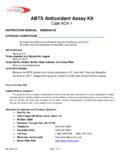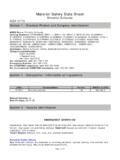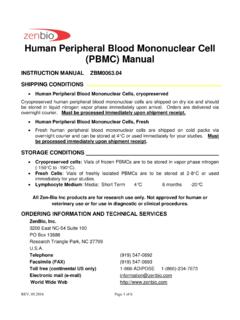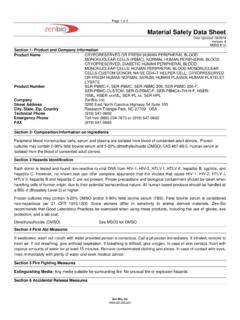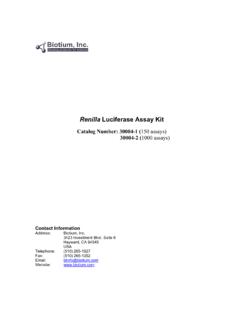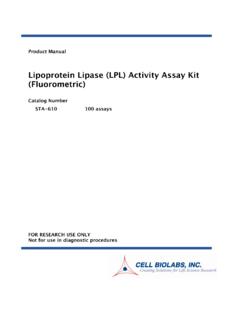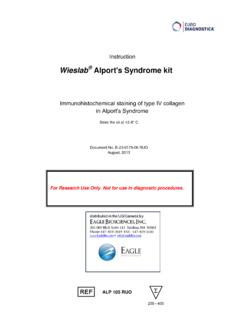Transcription of ORAC Antioxidant Assay Kit - Zenbio
1 Rev. July 2011 Page 1 of 9 New Bottom Read Assay ! ORAC Antioxidant Assay Kit (60 point kit) Cat# AOX-2 INSTRUCTION MANUAL STORAGE CONDITIONS All orders are delivered via Federal Express Priority courier at 4 C. All orders must be processed immediately upon arrival. Any adverse conditions upon arrival must be reported within 7 days. Fluorescein Solution Remove from box and store at 4 C Trolox Standard and AAPH Reagent Remove from box and store at -20 C AOX Assay Buffer and black Assay plate Store at Room Temperature Long-term Storage Reagents are good for at least 3 months upon arrival if stored properly. For in vitro Use Only LIMITED PRODUCT WARRANTY This warranty limits our liability to replacement of this product. No other warranties of any kind, expressed or implied, including without limitation, implied warranties of merchantability or fitness for a particular purpose, are provided by Zen-Bio, Inc.
2 Zen-Bio, Inc. shall have no liability for any direct, indirect, consequential, or incidental damages arising out of the use, the results of use, or the inability to use this product. ORDERING INFORMATION AND TECHNICAL SERVICES Zen-Bio, Inc. 3200 NC East Highway 54, Suite 100 PO Box 13888 Research Triangle Park, NC 27709 Telephone (919) 547-0692 Facsimile (FAX) (919) 547-0693 Toll Free 1-866-ADIPOSE (866)-234-7673 Electronic mail (e-mail) World Wide Web Rev. July 2011 Page 2 of 9 TABLE OF CONTENTS PAGE# Introduction 3 Principle of Assay 4 Items Included in the Kit 4 Sample Preparation 5 Assay Procedure 6 Trolox Standard Curve 7 Appendix A: Plate layout 8 Appendix B: Protocol Flowchart 9 References 9 Rev. July 2011 Page 3 of 9 INTRODUCTION Free radicals and reactive oxygen species (ROS) are highly reactive molecules that are generated by normal cellular processes, environmental stresses, and UV irradiation.
3 ROS react with cellular components, damaging DNA, carbohydrates, proteins, and lipids causing cellular and tissue injury. Excess production of reactive oxygen species can also lead to inflammation, premature aging disorders, and several disease states, including cancer, diabetes, and atherosclerosis. Organisms have developed complex Antioxidant systems to protect themselves from oxidative stress, however, excess ROS can overwhelm the systems and cause severe damage. The Zen-Bio ORAC (Oxygen Radical Absorbance Capacity) Antioxidant Assay Kit can be used to determine the total Antioxidant capacity of biological fluids, cells, and tissue. It can also be used to Assay the Antioxidant activity of naturally occurring or synthetic compounds for use as dietary supplements, topical protection, and therapeutics. The Assay measures the loss of fluorescein fluorescence over time due to peroxyl-radical formation by the breakdown of AAPH (2,2 -azobis-2-methyl-propanimidamide, dihydrochloride).
4 Trolox [6-Hydroxy-2,5,7,8-tetramethylchroman-2- carboxylic acid], a water soluble vitamin E analog, serves as a positive control inhibiting fluorescein decay in a dose dependent manner. The ORAC Assay is a kinetic Assay measuring fluroescein decay and Antioxidant protection over time. The Antioxidant activity in biological fluids, cells, tissues, and natural extracts can be normalized to equivalent Trolox units to quantify the composite Antioxidant activity present. This Assay measures Antioxidant activity by hydrogen atom transfer and when combined with Zen-Bio s ABTS Antioxidant Assay kit, provides a comprehensive analysis of a test sample s Antioxidant activity. Net AUC0255075100010203040 TroloxEGCGG allic AcidSample (uM)Net AUC Figure 1. Effects of antioxidants in ORAC Assay Trolox, Epigallocatechin gallate (EGCG), and Gallic acid were tested for their Antioxidant activity in the ORAC Antioxidant Assay .
5 Rev. July 2011 Page 4 of 9 PRINCIPLE OF THE Assay A peroxyl radical (ROO.) is formed from the breakdown of AAPH (2,2 -azobis-2-methyl-propanimidamide, dihydrochloride) at 37 C. The peroxyl radical can oxidize fluorescein (3 ,6 -dihydroxy-spiro[isobenzofuran-1[3H], 9 [9H]-xanthen]-3-one) to generate a product without fluorescence. antioxidants supress this reaction by a hydrogen atom transfer mechanism, inhibiting the oxidative degradation of the fluorescein signal. The fluorescence signal is measured over 30 minutes by excitation at 485 nm, emission at 538 nm, and cutoff=530 nm. The concentration of Antioxidant in the test sample is proportional to the fluorescence intensity through the course of the Assay and is assessed by comparing the net area under the curve to that of a known Antioxidant , trolox. AAPH ROO. fluorescein non-fluorescent product [ antioxidants inhibit the oxidation of fluorescein by hydrogen atom transfer] ITEMS INCLUDED IN THE KIT ITEM DESCRIPTION Cap Color UNIT QTY STORAGE Blank Assay Plates 96-well Assay plates, black clear bottom --- PLATE 1 ----- AOX Assay Buffer 50 ml --- BOTTLE 1 RT AAPH 130 mg --- BOTTLE 1 -20 C Trolox (AOX-2) in AOX Buffer 20 l /VIAL 1 -20 C Fluorescein Solution 60x stock 300 l /VIAL 1 4 C Tray For multi-channel pipetters, clear polyvinyl --- EACH 1 ----- 4 Other equipment/reagents required but not provided with the kit: Multi-channel Pipet , single channel pipet and pipet tips Tubes for preparing standards and working solutions Fluorescence plate reader able to perform excitation=485nm; emission=528 -538nm (cutoff=530nm, if necessary) Fluorescence plate reader with incubator chamber set to 37 C Rev.
6 July 2011 Page 5 of 9 SAMPLE PREPARATION Cell Lysate Preparation 1. Scrape ~1 x106 cells and centrifuge at 1,000xg to prepare a cell pellet. DO NOT use proteolytic enzymes such as trypsin but scrape using a rubber policeman or cell scraper tool. 2. Homogenize or sonicate the cell pellet on ice in 1ml cold AOX Assay buffer 3. Centrifuge at 10,000 x g for 15 minutes at 4C. 4. Remove the supernatant and keep on ice until ready to use in the Assay . 5. If not using the same day, store the samples at -80C. 6. Data is expressed as Trolox equivalents (TE) per cell number ( mole TE/106 cells) Tissue Lysate Preparation 1. Homogenize tissue samples on ice in cold buffer at ~200mg tissue per ml cold buffer 2. Centrifuge at 10,000 x g for 15 minutes at 4C. 3. Remove the supernatant and keep on ice until ready to use in the Assay . 4. If not using the same day, store the samples in small aliquots at -80C. 5. Data is expressed as Trolox equivalents (TE) per gram of starting sample ( M TE/g) Plasma Preparation 1.
7 Collect the blood in a tube containing heparin or other anticoagulant. 2. Centrifuge at 1,000 x g for 10 minutes at 4C. 3. Remove the supernatant and keep on ice until ready to use in the Assay . 4. If not using the same day, store the samples in small aliquots at -80C. 5. Data is expressed as micromoles Trolox equivalents (TE) per volume sample ( mole TE/L) Serum Preparation 1. Collect the blood in a tube WITHOUT any anticoagulant. Allow the blood to clot. 2. Centrifuge at 2,000 x g for 10 minutes at 4C. 3. Remove the supernatant and keep on ice until ready to use in the Assay . 4. If not using the same day, store the samples in small aliquots at -80C. 5. Data is expressed as micromoles Trolox equivalents (TE) per volume sample ( mole TE/L) Saliva Collection 1. Collect whole saliva for a defined period of time ( 1-5 minutes) into polypropylene tubes. 2. Immediately place on ice or store at -80C for later analysis. 3. Data is expressed as micromoles Trolox equivalents (TE) per volume sample ( mole TE/L) Food Extract Preparation 1.
8 Weigh the starting material. 2. Homogenize in a small volume ice cold buffer or water. 3. Store small aliquots at -80C for analysis. 4. When ready to Assay , keep thawed samples on ice. 5. Data is expressed as Trolox equivalents (TE) per gram of starting sample ( M TE/g) Rev. July 2011 Page 6 of 9 Assay PROCEDURE THIS KIT PROVIDES SUFFICIENT REAGENTS TO Assay 60 WELL. AT LEAST 6 OF THESE WELLS ARE REQUIRED FOR TROLOX STANDARDS 1. Equilibrate the plate reader incubation chamber to 37 C before beginning. Set-up plate reader to perform a kinetic read for 30 minutes with 1 minute intervals. Excitation = 485 nm; Emission = 528 - 538 nm (Cutoff = 530 nm, if required). SET PLATE READER TO BOTTOM READ. 2. Prepare fluorescein working solution from the stock solution provided by transferring of AOX Assay Buffer to an empty tube (not provided) and adding stock fluorescein solution. Mix and protect from light.
9 3. Prepare Trolox standards as follows: Briefly spin down the contents of the mM Trolox standard tube after thawing. Pipette 280 l of AOX Assay Buffer into the mM Trolox standard tube provided and mix well by vortexing. This produces a diluted stock Trolox standard of 100 M. Pipette 150 l of AOX Assay Buffer into 4 tubes (not provided). Using the newly diluted stock Trolox solution, prepare a dilution series as depicted below. Mix each new dilution thoroughly before proceeding to the next. The 100 M stock dilution serves as the highest standard, and the Assay buffer serves as the zero standard. 4. Add 150 l of the working fluorescein solution to each of the INNER 60 WELLS of the Assay plate provided. 5. Add 25 l of samples or Trolox standards to individual wells of the Assay plate provided, add 25 l of Assay buffer to individual wells as a negative control. Place plate at 37 C for at least 10 minutes.
10 6. While the Assay plate is equilibrating to 37 C, prepare the AAPH Working Solution by adding ml AOX Assay Buffer to the AAPH tube provided and gently invert. Place the working solution on ice until needed. AAPH solution is good for 8 hours if kept on ice. 7. To begin the Assay , add 25 l of the AAPH working solution to each of the wells containing standards and samples from step 5. Place the Assay plate in the plate reader and begin kinetic fluorescence reading. Std 150 l 280 l 150 l 150 l AOX Assay Buffer 50 M 25 M M M 150 l 100 M Rev. July 2011 Page 7 of 9 (Minutes) (M)Net AUCTROLOX STANDARD CURVE . Generate standard curve: see example below (Collected using BioTek Synergy 2) [DO NOT use this standard curve to generate your data. This is an example.] Kinetic RLU Values Normalized to Time=0 by (RLU/RLU0) Concentration of Trolox in Concentration of Trolox in Use normalized data to generate Area Under the Curve (AUC) values.

